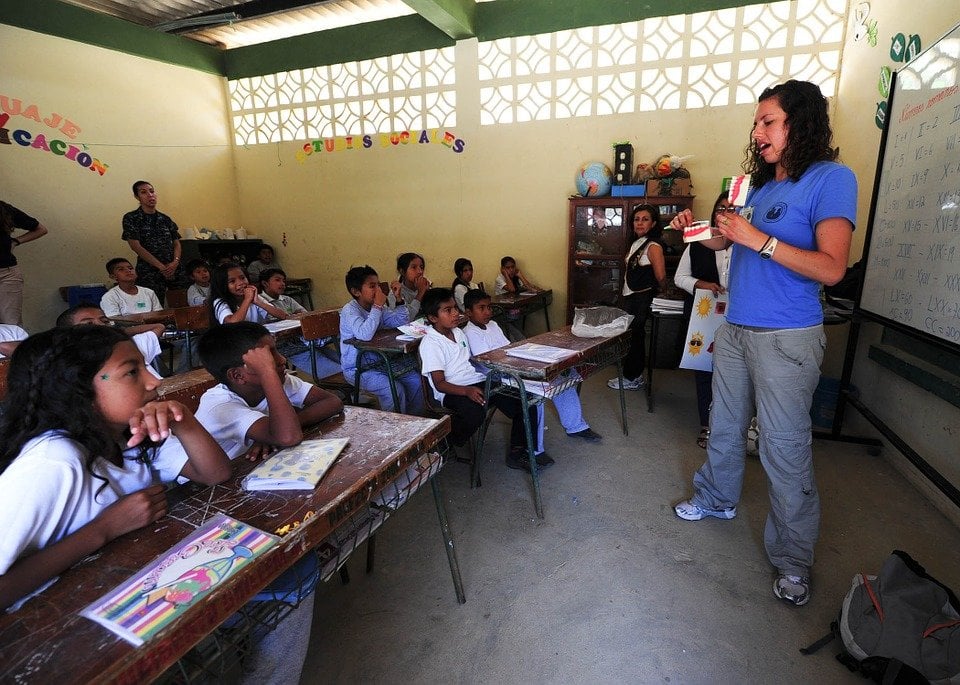How to Teach ESL: Differences for Children and Adults
Unsure whether you should teach kids, teens, or adults? We've outlined the key considerations and strategies to keep in mind for every age group so you can hit the ground running at your new ESL teaching job!

After finishing university, I did what thousands of new graduates do every year: I signed up to teach English abroad and moved to suburban Tokyo, Japan for a year and a half. Being a native English speaker and having a degree in English, but no teaching experience (and certainly no ESL training), it was very easy for me to walk into a job. But, that didn’t mean the job itself was easy.
During my time teaching in Japan (which included the original company I worked for going bankrupt - but that’s another story!), I worked in a variety of different ESL contexts: public elementary and junior high schools, one-on-one and group lessons for adults, business English, even private small-group lessons for preschoolers. The job was fun, most of the time, but each age group presented extremely different challenges.
Kids are, by nature, energetic and have short attention spans, so classes with kids are often full-on, and require a lot of creativity. Teaching adults requires more patience and technical (read: grammar!) knowledge, as adults have specific reasons for learning English but are often slower to learn.
There are a few crucial differences between how and why children and adults learn. Keep these differences in mind so you can cater your lessons specifically to your students, and even know which type of job to apply for.
Children and adults learn languages differently
Whichever age group you’re teaching, it helps to understand the different stages of language-learning that happen throughout life.
Children’s natural ability to acquire new languages is strong before adolescence. Pronunciation comes more easily, and vocabulary sticks during this time. In fact, linguists don’t say that children learn a language but that they acquire it. You don’t really need to teach young kids a language because they will pick it up. They learn implicitly rather than explicitly. Easy, right?
Anyone who has spent any time with kids, though, will tell you that the struggle is to keep them focused and interested, rather than to get them to learn. So, teaching kids requires small person-handling skills as much as it does language teaching prowess.
Read more: How to Create the Perfect ESL Lesson Plan
Tips for Teaching ESL to Children

Small children don’t have a driving motivation to learn languages. Their attention is fueled by curiosity and imagination. Anything and everything is potentially interesting to a younger child. It takes a lot of energy to teach them, especially full time over the course of a week, but it might be an ideal job for you if you’re creative and enthusiastic. Here are some things to keep in mind when teaching children.
1. Keep the momentum moving
Classes with children don’t run on autopilot, and you’re less likely to have to follow a set curriculum than you are when teaching older kids. It may even be up to you to plan your classes from scratch.
If a group of 6-year-olds doesn’t have something to do, don’t expect them to sit quietly like angels and wait until you’re ready. That’s why it's important to always have your materials prepared before class and have backup lessons at hand for times when Plan A takes a nosedive.
2. Don’t over-correct
Young children learn English just as they learned their native language: through experience and interaction. They aren’t consciously studying structure and grammar rules, so keep your corrections natural. If they make a mistake, just repeat back the correct sentence. For example, if your student says, “He goed to the park,” you could respond, “Yes, he goes to the park.”
3. Movement and activity is key
Not only is movement and activity a part of childhood, but it actually helps the learning process and keeps students involved in your lessons. In your classroom, try games like “Simon Says”, or pass around a ball and have each student answer a question when they catch it.
4. Use songs & flashcards
Think back to your high school language classes. I’m sure we all remember the words to at least one catchy song, even if we still can’t give directions or order food to save our lives! Music is powerful, and fun songs will keep your students engaged and help them pick-up new vocabulary.
Similarly, some students are visual learners, especially younger kids who aren’t fully literate in their own languages, let alone a second. Holding up or pinning colorful flashcards to the board while learning vocab is ideal for helping them remember words.
5. Remember classroom management
You may be working alongside a local teacher who is more responsible for the classroom management side of teaching or you might have to go it alone. Either way, a big part of teaching young kids is managing their behavior.
Using a consistent “quiet signal” is an effective way to manage a big group (and groups will often be big, especially in public schools). A good signal is clapping three times, having students repeat the rhythm back and falling silent after they’ve finished. Other teachers will use a hand single which they’ll hold up until all students are quiet and making the same sign. No matter what happens, never shout over them. Raising your voice to get their attention can make them used to talking over you, so stay calm.
6. Don’t try to be a rockstar
One of the biggest complaints I heard through the ESL teaching grapevine in Japan was Japanese teachers of English who resented foreign teachers who played the “rockstar” card. For young kids, having a foreigner lead their class is interesting and exciting, especially if it doesn’t happen very often, such as once a week or even just once a term. It’s easy for kids to get whipped up into an exciting English-teaching frenzy, and some teachers encourage that because they think it means their students are engaged and motivated.
If you want to have a good relationship with your local teachers, it might be a good idea to put yourself in their position. They have to teach their students for the rest of the day, or week, when you’re not there. They have to be the disciplinarian and teach things that might seem a bit more “boring” than English. They do their best to keep energy levels at a manageable level so that everyone can learn (and hear each other). The noise from lessons with rockstar English teachers can reverberate around the school and excite students for the rest of the day.
We’re not saying to avoid having fun! Quite the opposite. But it’s a good idea to mix quiet, individual activities into your lessons, too.
Tips for Teaching ESL to Teenagers

Older children, such as junior high and high school students, can be more difficult to excite. They will often be studying English because they have to, either because it’s a requirement at school or because their parents want them to excel with extracurricular lessons. They don’t necessarily have the inherent curiosity of a younger child, but they also don’t have the motivation and discipline of an adult learner.
Cultural factors also play into this, as in some cultures it’s not ‘cool’ or acceptable to be too talkative or inquisitive, while in others it’s the opposite. Your biggest challenge will be planning activities that engage everyone.
1. Their interests are key
Let’s face it - many teens are self-centered (in the best possible way!) They’re more likely to be motivated when the lesson comes back to them and their interests. A great tactic is to do a survey at the beginning of term, or at the beginning of your block of lessons, to gauge your students’ interests. Whatever their interests (which are likely to revolve around sports, movies, celebrities, pop culture, and current events), you can build them into your future lessons.
2. Hone your empathy
Academic stress. Crushes. Self-consciousness. Peer and parental pressure. There are a lot of moving parts here. The best thing you can do is to create a comfortable classroom for your teens. Be especially aware of the kinds of activities you plan — yes, you want to challenge them, but don’t continually put students on the spot in front of their peers. Self-consciousness flourishes now, and speaking English in front of their peers can compound these feelings.
3. Create a strong rapport
It’s surprising how something as simple as asking a student how their day is going can open up so much. It breaks down this invisible barrier. Talk with them after class if you notice they’re lingering at your desk, or say hi in the halls, perhaps giving them the chance to casually practice a phrase or two you learned in class. Depending on your country’s social norms, if you can comfortably make these friendly, personal connections then go for it!
4. Work creatively with the curriculum
Most teens in a school setting, or studying after class, will be learning English with some type of exam as an end goal. Depending on the country you’re teaching in, you may have a rigid curriculum you have to follow (as I did when teaching in Japan). If so, diverging from it too far will not be a good idea because the students will be tested on very specific things, and failing to teach those things could cause problems for them.
But, there are ways you can make even dry textbooks fun. Have students act out the dialogues rather than you repeating them like a human tape recorder. Find songs and videos and pictures that are related to the curriculum to help students cement new words and concepts in their minds.
Tips for Teaching ESL to Adults

Adults have more varying levels, needs, and difficulties when it comes to learning a new language. Around puberty, the natural ability to pick up a second language drops, and continues to do so as we get older (although it’s not all bad news for adult learners - we have some advantages, too).
Adults must deliberately and consciously learn a language to gain proficiency or fluency. If you’re teaching adults who are absolute beginners and have no previous experience or exposure to English, this can be a big challenge for them. Even adults with previous exposure can easily forget what they’ve learned, struggle with grammatical concepts that are different from their native tongue, and feel more self-conscious or embarrassed about their skills and progress.
Adults also have very specific, but diverse, reasons for learning English. They might be preparing for university abroad, trying to gain a new skill for their career at home, or planning on immigrating to an English-speaking country. ESL teachers will often teach in private language schools, and you may have a mix of reasons for studying English within the same class. The role of the teacher will become more strategic than teaching kids, and you’ll need to closely monitor your students’ progress to help them reach their specific goals.
1. Never equate language ability with intelligence
If your student is struggling to understand something you think is a simple concept, make sure you’re responding with patience and respect. Your tone, body language, and actions will all reveal your attitude. Students pick up on this, no matter how little English they know. Remember, learning English is just one slice of their life, and even though you have more skills in this area, they may have more professional and life experience than you do. Stay humble and respectful.
2. Teach casual language and idioms
Many students are interested in getting practice with everyday, colloquial phrases. This kind of language, ever-changing, can’t be taught in textbooks, and many adults need it for professional (and personal) situations. If you’re teaching business English, for example, make it a point to practice common workplace phrases, such as “on the ball” and “kept under wraps.”
3. Use age-appropriate activities
Even if your adult students are basic beginners, make sure your lessons are relevant to their lives. Using children’s storybooks or songs, while simple and effective, may appear condescending to them. (And, in fact, kids’ books designed for native speakers of English can have some difficult and obscure vocabulary that adult learners probably don’t need to know).
Instead, plan your lessons around their present goals, such as how to fill out a job application, prepare for a citizenship test, or practice interview questions for a new job.
4. Provide detailed and encouraging feedback
Encouragement is paramount with adults. They may be easily discouraged if they struggle or take a long time to remember something. Before beginning to teach, get a clear picture of your students’ language level, and use what they already know to help build their confidence. From there, you can start adding new language, and they’ll feel better knowing they have a foundation to stand on.
Which Program is Right for You?
As a teacher, your students’ needs (should) come first. While it may be tempting to choose an ESL teaching program based upon your dream location and travel opportunities, it’s also important to consider your own strengths, training, and needs, and how these can best serve your potential students.
If you have no experience teaching young kids, you may find an ESL job teaching kindergarten exhausting, which won’t allow you to be the best teacher possible. Likewise, if you’re a trained elementary school teacher, the rigor and precision of teaching adult learners may challenge you in ways you didn’t anticipate (or want).
Some ESL teaching jobs abroad will only require you to teach one age group, while others will expect you to hop around a bit, so you may be teaching first grade one day and business English the next. Investigate what you’re signing up for, ask specific questions if you’re unclear from an organization’s recruitment materials, and be prepared to “shop around” for a program that will suit your skills and help you help your students best.
Avoid going into your ESL teaching job with a "one size fits all" mindset. Whichever age group you teach, you can’t go wrong with a solid lesson plan, patience, and an understanding of your students’ goals and needs. Take your job seriously and your students will too!
Some recommended programs:
- Reach to Teach places teachers in private and public schools in South Korea
- Footprints Recruiting arranges teaching jobs through the Ministry of Education in the United Arab Emirates
- Teach Away seeks teachers for students spanning from pre-K to adults in China.
- The Jet Programme lets teachers choose between teaching in public schools or in local government offices in Japan.
- If you’re unable to travel at this point in your life or career but still want to teach ESL to students abroad, look into the variety of online teaching jobs available.
This article was originally published in October 2013, and it was updated in January 2021.
